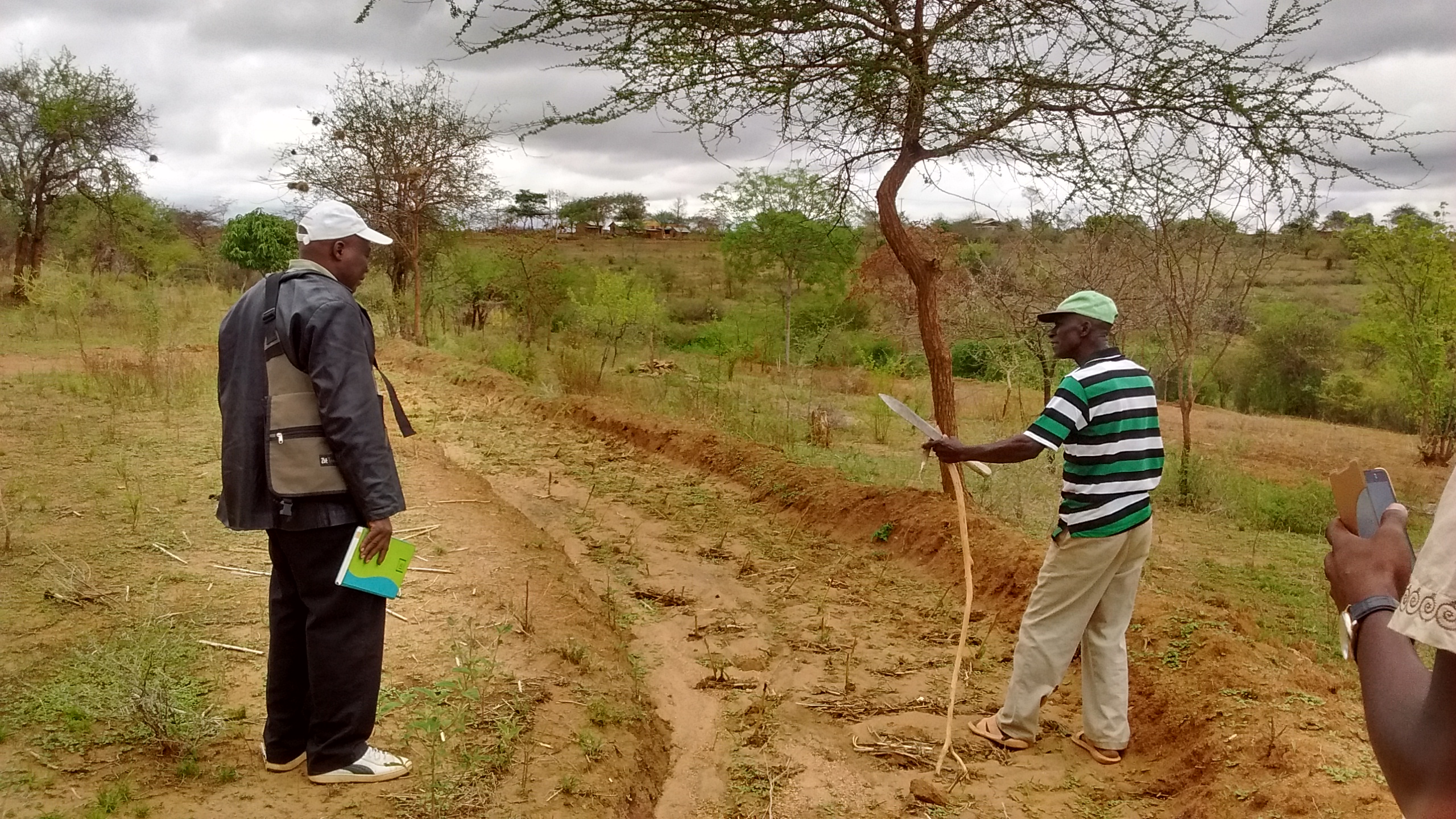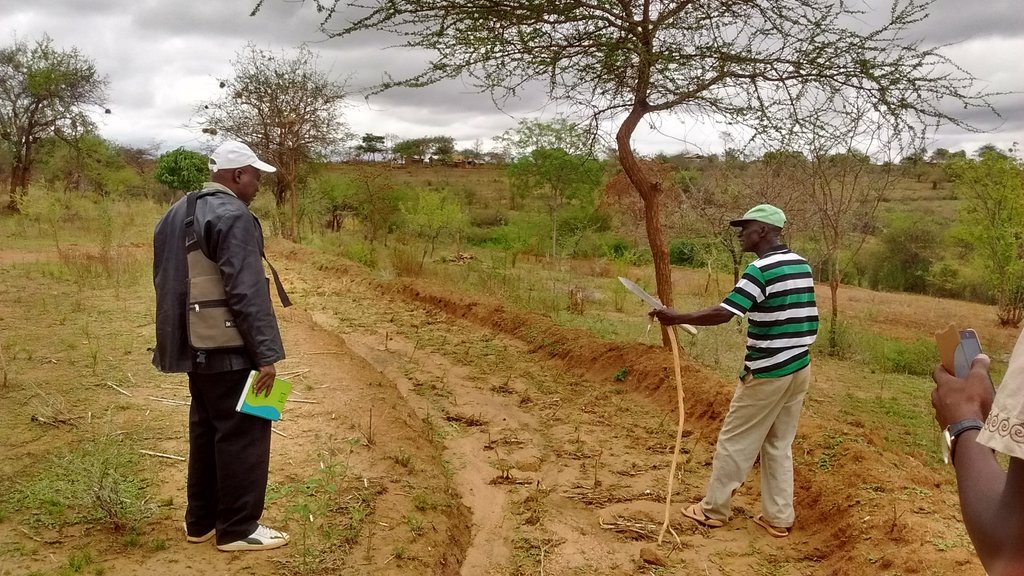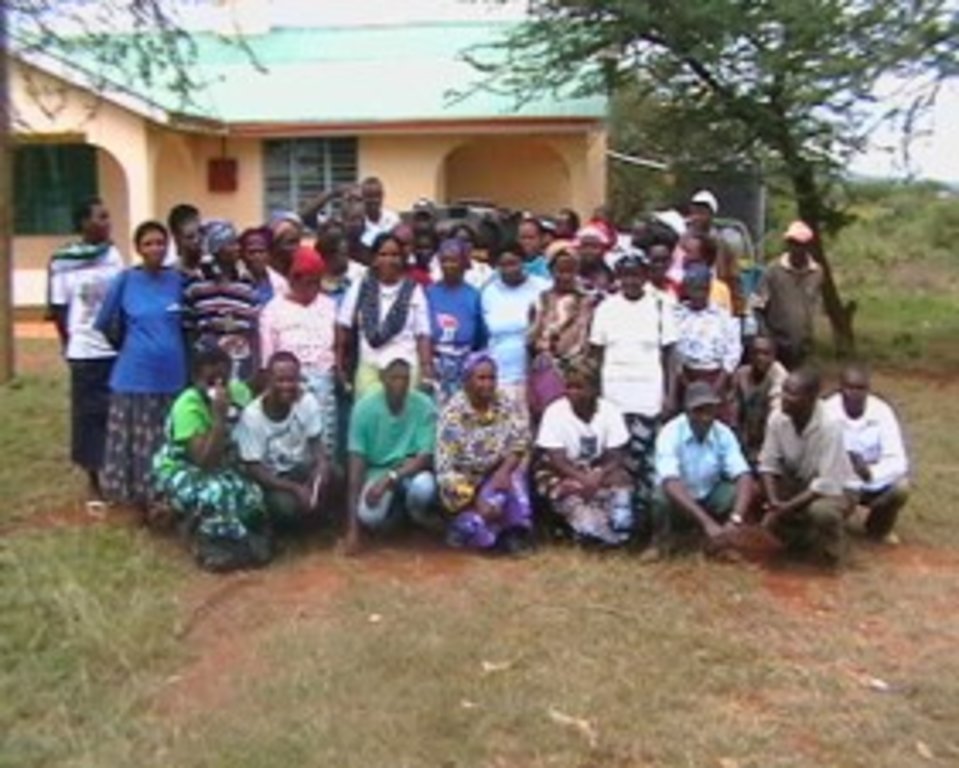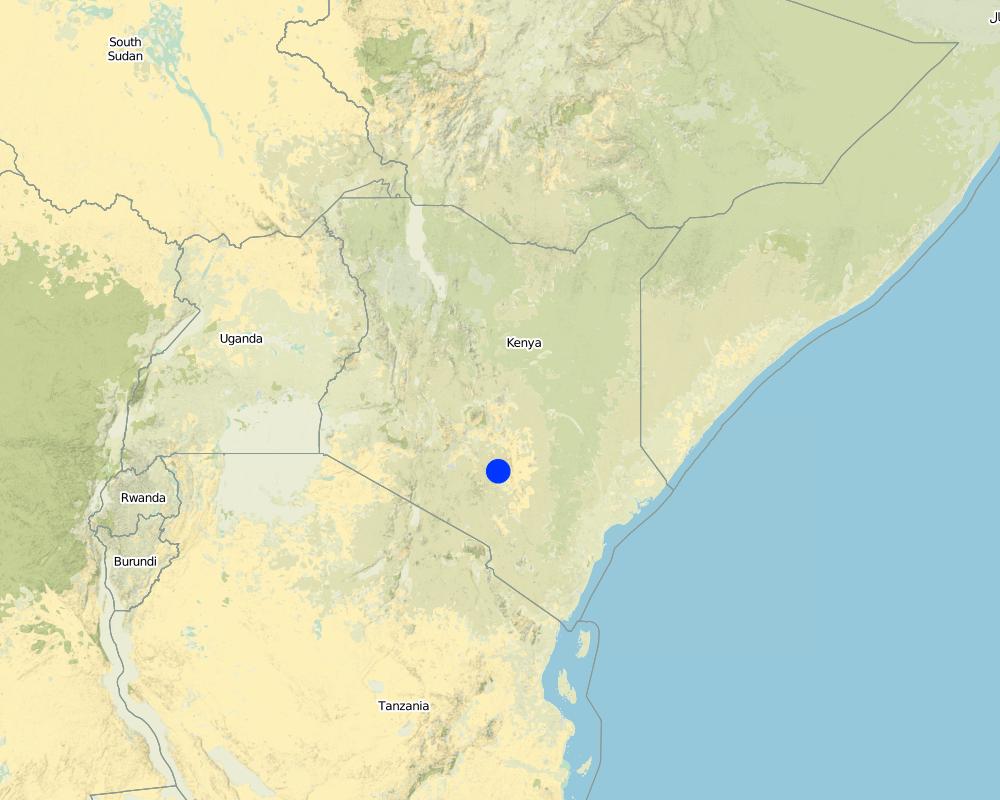On-farm indigenous pasture establishment demonstrations [肯尼亚]
- 创建:
- 更新:
- 编制者: Kevin Mganga
- 编辑者: –
- 审查者: Rima Mekdaschi Studer
On-farm demos
approaches_3285 - 肯尼亚
- In-situ pasture establishment demonstrations: Jan. 26, 2018 (inactive)
- On-farm pasture establishment demonstrations : Feb. 21, 2018 (inactive)
- On-farm indigenous pasture establishment demonstrations : April 20, 2018 (inactive)
- On-farm indigenous pasture establishment demonstrations : Sept. 3, 2018 (public)
查看章节
全部展开 全部收起1. 一般信息
1.2 参与方法评估和文件编制的资源人员和机构的联系方式
关键资源人员
SLM专业人员:
有助于对方法进行记录/评估的项目名称(如相关)
Book project: Guidelines to Rangeland Management in Sub-Saharan Africa (Rangeland Management)有助于对方法进行记录/评估的机构名称(如相关)
Department of Range and Wildlife Sciences, South Eastern Kenya University (SEKU) - 肯尼亚1.3 关于使用通过WOCAT记录的数据的条件
(现场)数据是什么时候汇编的?:
10/11/2017
编制者和关键资源人员接受有关使用通过WOCAT记录数据的条件。:
是
1.4 SLM技术问卷的参考
2. SLM方法的描述
2.1 该方法的简要说明
On-farm indigenous pasture establishment demonstrations offer a practical approach to encourage adoption in the arid and semi-arid environments in Kenya.
2.2 该方法的详细说明
该方法的详细说明:
The characteristic feature of the demonstration approach is the interaction of different stakeholders in on-farm showcasing of sustainable land management technologies. The stakeholders include land users, NGOs, SLM specialists, local government officials and university researchers. SLM specialists and university researchers, with the help of local government and NGO field officers demonstrate the entire process of grass reseeding from site selection, seedbed preparation, grass species selection, weeding, monitoring and evaluation of both plant and soil parameters. The method comprises on-farm demonstrations both at individual, and pastoral and agropastoral group sites, and a model demonstration site within the university premises. The role of the main stakeholders involved in the process are sharing the knowledge, skills and technology (the SLM specialists; researchers from the university), linking the SLM specialists with the pastoral communities, sharing their experiences through on-farm demonstrations and explanations of similar technologies local government (county officials), sharing knowledge of past experiences and skills (local NGOs). The end users of the technologies, namely the pastoral communities share their indigenous technical knowledge related to natural resource management. In this case study the end-users comprised approximately 40 livestock keepers. Over five visits and through the demonstrations, they liked the approach because it was more practical being on-farm (“seeing is believing”). It was appreciated as being easily replicated on their own land under the same local conditions of climate, soil type, grass species, methods of land preparation, and land use system. After interacting with the SLM specialists from the universities during the visits and on-farm demonstrations, land-users have adopted the technology to ensure a continuous supply of pasture for their livestock.
2.3 该方法的照片
2.5 采用该方法的国家/地区/地点
国家:
肯尼亚
区域/州/省:
Eastern Province
有关地点的进一步说明:
Kitui municipality, Kitui county
Map
×2.6 该方法的开始和终止日期
若不知道准确的年份,请注明该方法的大致开始日期。:
不到10年前(最近)
2.7 方法的类型
- 最近的本地倡议/创新
2.8 该方法的主要目的/目标
To demonstrate indigenous pasture establishment on-farm, and encourage land users to practice reseeding as a means of 1) rehabilitating their degraded lands, 2) providing forage for their livestock and 3) income generation through sale of surplus animal products i.e. milk, hay and seeds.
2.9 推动或妨碍实施本办法所适用的技术的条件
社会/文化/宗教规范和价值观
- 启动
Land users are livestock keepers so technologies and approaches to improve livestock production are welcome.
- 阻碍
Gender-based constraints where men dominate on-farm training/demonstrations compared to female land users.
财务资源和服务的可用性/可得性
- 启动
Facilitation from previous (Agricultural Innovation for Dryland Africa, AIDA) and on-going research project (Rainwater Harvesting for Indigenous Pasture Production, ROFIP, in semi-arid Kitui County, Kenya). The current ROFIP project is under the Food and Business Applied Research Fund (ARF) funded by the he Netherlands Organisation for Scientific Research (NWO).
- 阻碍
Accessing money/financial resources from government/public institutions and organisation is long (much slower) due to e.g. bureaucracy and protocol, compared to private organisation (much faster access, less bureaucratic).
机构设置
- 启动
The university encourages extension service delivery to the local community and supports such initiatives to reach out to land users to share knowledge and expertise.
- 阻碍
Coordinating different stakeholders both in the private (NGO) and public sector (university, local government), together with land users is often a challenge mainly due to the different nature of operations e.g. bureaucracy, protocol.
参与者的的协作/协调
- 启动
Collaboration between university, local government and local land users.
- 阻碍
Different stakeholders (e.g. land users, university, local government, NGOs) all have different key objectives to achieve within the general aim/objectives. This often hinders the coordination of actors and implementation of the approach.
法律框架(土地使用权、土地和水使用权)
- 启动
Land used in the approach for demonstrating the reseeding technology is privately owned.
- 阻碍
Land ownership is private, communal and group. This determines the organisation and arrangement of the approach.
土地治理(决策、实施和执行)
- 启动
了解SLM,获得技术支持
- 启动
SLM specialists have knowledge about the SLM technologies and various approaches.
市场(购买投入,销售产品)和价格
- 启动
- 阻碍
Some of the inputs especially indigenous grass seeds, are not available in the formal seed market in Kenya. Reliance on the informal seed market often leads to the purchase and use of uncertified seeds with poor end results.
工作量、人力资源可用性
- 启动
Use of local casual labourers. This contributes to “ownership” of the project activities and easier implementation in their individual farms.
- 阻碍
Division of labour between the project demonstration sites and individual activities. This may lead to delays in implementing project activities.
3. 相关利益相关者的参与和角色
3.1 该方法涉及的利益相关者及其职责
- 当地土地使用者/当地社区
local land users and livestock keepers
Share their indigenous technical knowledge; provide land for on-farm demonstrations.
- SLM专家/农业顾问
university researchers
Describe the technologies using practical on-farm demonstrations. Additionally, share and present scientific research findings to demonstrate the contribution of the use of the technology for increased indigenous pasture production: i.e. evidence-based.
- 教师/学龄儿童/学生
university students
Practical demonstrations
- NGO
Local NGO (Roads for Water)
Collaborate with university researchers to demonstrate to different land users and managers (e.g. researchers, pastoral and agro-pastoral communities) how other land management strategies e.g. rainwater harvesting using roads as catchments can be incorporated in reseeding programmes to enhance pasture establishment, especially in dryland environments.
- 地方政府
Extension agents and advisors in the county government
Link to the end-users, share past experiences and knowledge on SLM approaches
3.2 当地土地使用者/当地社区参与该方法的不同阶段
| 当地土地使用者/当地社区的参与 | 指定参与人员并描述活动 | |
|---|---|---|
| 启动/动机 | 互动 | Local land users involved in the site selection and involved in the plans of the project. Local land users share their indigenous technical knowledge gained through years of experience on aspects such as: which species are preferred by grazing animals (i.e. ranking of different forage species); which grass species perform better under different rainfall regimes, topography and soil types; which grass species are best suited for soil conservation and soil erosion control. |
| 计划 | 互动 | Local land users actively involved in deciding on schedule for land users visits and demonstrations. Local land users participate and contribute to the planning of sowing dates, methods of land preparation, grass species selection in relation to their individual taste and preference and intended use (fodder for livestock, soil conservation and combating degradation, large-scale seed production). |
| 实施 | 互动 | Demonstration conducted on individual 'farms'/ pastures and local land users implement the technologies as 'model land users'. |
| 监测/评估 | 互动 | Constant communication through short message services (SMS) and telephone calls on progress and challenges as land users monitor changes, e.g. seed germination and seedling establishment. Local land users report this to the SLM specialists e.g. researchers in the university and post-graduate students involved in the projects. |
| Research | 被动 | Research is mainly conducted by SLM specialists at university and students. The local government is also involved in research since some of the students recruited to be part of the project: for example PhD and MSc students are permanently employed by the local government. Local land users share their indigenous technical knowledge through one-on-one informal discussions/sessions between them and the SLM specialists and students. |
3.3 流程图(如可用)
具体说明:
Interaction between different stakeholders (SLM specialists, local government, local NGOs and land users) for pasture establishment demonstrations in arid and semi-arid environments in Kenya.
作者:
Kevin Z. Mganga
3.4 有关SLM技术选择的决策
具体说明谁有权决定选择要实施的技术:
- 所有相关参与者,作为参与式方法的一部分
明确做出决策的依据:
- 对充分记录的SLM知识进行评估(基于证据的决策)
- 研究结果
- 个人经验和意见(无记录)
4. 技术支持、能力建设和知识管理
4.1 能力建设/培训
是否为土地使用者/其他利益相关者提供培训?:
是
明确受训人员:
- 土地使用者
- 现场工作人员/顾问
如果相关,请说明性别、年龄、地位、种族等。:
The land users and field staff/advisers were drawn from both genders (male and female). University undergraduate students (both male and female students, between the ages of 20-24 years) were also involved in the training during on-farm practical sessions.
培训形式:
- 示范区域
涵盖的主题:
site selection, seedbed preparation, choice of grass species, monitoring and evaluation (plant and soil attributes), maintenance and further management.
4.2 咨询服务
土地使用者有权使用咨询服务吗?:
是
指明是否提供了咨询服务:
- 在土地使用者的土地上
说明/注释:
Advisory services on-farm during visits.
4.3 机构强化(组织发展)
是否通过这种方法建立或加强了机构?:
- 是,适度
具体说明机构的强化或建立程度:
- 本地
- 区域
- 国家
说明机构、角色和职责、成员等。:
University (South Eastern Kenya University, SEKU) - extension and outreach and research and academic exchange programs with other research institutions e.g. Kenya Agricultural and Livestock Research Organisation (KALRO), International Crops Research Institute for the Semi-Arid Tropics (ICRISAT), Kenya Seed Company, and other universities, for example the University of Nairobi (UoN).
具体说明支持类型:
- 财务
- 能力建设/培训
提供进一步细节:
Financial support from within university research funds and the National Research Fund (NRF), Kenya, through the Ministry of Education, Science and Technology. Capacity building through postgraduate training involving researchers from SEKU, KALRO, ICRISAT and UoN.
4.4 监测和评估
监测和评估是该方法的一部分吗?:
是
注释:
Adoption and uptake of the technologies among land users.
若是,该文件是否用于监测和评估?:
是
注释:
The approach demonstrates sustainable land management technologies e.g. grass reseeding, on farm. This is aimed at increasing adoption and spread of the technology by other land users.
4.5 研究
研究是该方法的一部分吗?
是
明确话题:
- 生态学
- 技术
提供进一步的细节,并指出是谁做的研究:
By an SLM specialist: that is researcher at the university under a research project.
5. 融资和外部物质支持
5.1 该方法中SLM组成部分的年度预算
如果不知道准确的年度预算,请给出一个范围:
- 2,000-10,000
注释(例如主要的资助来源/主要捐助者):
Food and Business Applied Research Fund (ARF) funded by the The Netherlands Organisation for Scientific Research (NWO), Netherlands.
5.2 为土地使用者提供财政/物质支援
土地使用者是否获得实施该技术的财政/物质支持?:
是
如果是,请具体说明支持的类型、条件和提供者:
Land and seed bed preparation: hiring of casual labour and rent of machinery / equipment (ox-plough / tractor).
5.3 对特定投入的补贴(包括劳动力)
- 劳动力
| 程度如何 | 对补贴做出具体说明 |
|---|---|
| 部分融资 | Cash subsidy mainly for land/site preparation e.g. creating of micro-catchments using ox-driven ploughs, digging trenches as structures for rainwater harvesting. |
- 设备
| 具体说明哪些投入得到了补贴 | 程度如何 | 对补贴做出具体说明 |
|---|---|---|
| 机械 | 充分融资 | Ox-driven ploughs for site preparation. Occasionally tractors. |
| 工具 | 充分融资 | Hand hoes for bush clearing and site preparation. |
- 农业
| 具体说明哪些投入得到了补贴 | 程度如何 | 对补贴做出具体说明 |
|---|---|---|
| 种子 | 充分融资 | Indigenous grass seeds used in the technology and approach are provided for by the project. However, seed for subsequent sowing is expected to be harvested from the established pasture sites. |
如果土地使用者的劳动力是一项重要的投入,那么是不是:
- 自愿
注释:
This is mainly for maintaining, monitoring and evaluation of the on-farm sites e.g. aspects of maintaining the fence to keep of free-ranging livestock from damaging the established pastures and assisting other hired labourers e.g. in seeding.
5.4 信用
是否根据SLM活动的方法给予信用值?:
否
5.5 其它激励或手段
是否有其他激励措施或工具用于促进SLM技术的实施?:
否
6. 影响分析和结论性陈述
6.1 方法的影响
该方法是否有助于当地土地使用者,提高利益相关者的参与度?:
- 否
- 是,很少
- 是,中等
- 是,支持力度很大
They owned and embraced the initiative since it involved them from the onset.
这种方法是否有助于基于证据的决策?:
- 否
- 是,很少
- 是,中等
- 是,支持力度很大
On-farm sites are used for both demonstrations and experimental plots for research. This is mainly conducted by SLM specialists from the university and postgraduate students in close collaboration with land users (e.g. farmers) aimed at comparing different treatments for the technologies.
该方法是否帮助土地使用者实施和维护SLM技术?:
- 否
- 是,很少
- 是,中等
- 是,支持力度很大
Practical on-farm demonstrations in their individual farms.
该方法是否提高了SLM的协调性和成本效益?:
- 否
- 是,很少
- 是,中等
- 是,支持力度很大
Communication through SMS and phone calls, exchange of photos/videos of demonstrations through WhatsApp groups and emails.
该方法是否调动/改善了使用财务资源实施SLM的途径?:
- 否
- 是,很少
- 是,中等
- 是,支持力度很大
Joint research grants and funds through collaborative work among stakeholders mostly between local NGOs and universities.
该方法是否提高了土地使用者实施土地管理的知识和能力?:
- 否
- 是,很少
- 是,中等
- 是,支持力度很大
Through practical and hands-on on-farm demonstrations by SLM specialists.
该方法是否提高了其他利益相关者的知识和能力?:
- 否
- 是,很少
- 是,中等
- 是,支持力度很大
Local government and NGOs appreciating the technologies and serve as ambassadors of the same.
该方法是否建立/加强了机构、利益相关者之间的合作?:
- 否
- 是,很少
- 是,中等
- 是,支持力度很大
Collaboration between universities, local government, local NGOs and land users strengthened.
该方法是否缓解了冲突?:
- 否
- 是,很少
- 是,中等
- 是,支持力度很大
该方法是否有助于社会和经济弱势群体?:
- 否
- 是,很少
- 是,中等
- 是,支持力度很大
该方法是否改善了性别平等并赋予女性权力?:
- 否
- 是,很少
- 是,中等
- 是,支持力度很大
Female land users involved.
该方法是否鼓励年轻人/下一代土地使用者参与SLM?:
- 否
- 是,很少
- 是,中等
- 是,支持力度很大
Young farmers involved. Also students in universities as part of practical field work.
该方法是否改善了粮食安全/改善了营养?:
- 否
- 是,很少
- 是,中等
- 是,支持力度很大
Improved pasture production for livestock, healthy animals.
该方法是否改善了市场准入?:
- 否
- 是,很少
- 是,中等
- 是,支持力度很大
Market for sale of grass seeds.
该方法是否提高了土地使用者适应气候变化/极端情况和减轻气候相关灾害的能力?:
- 否
- 是,很少
- 是,中等
- 是,支持力度很大
Combining the use of indigenous drought tolerant grass species and water harvesting.
该方法是否会带来就业、收入机会?:
- 否
- 是,很少
- 是,中等
- 是,支持力度很大
Through sale of grass seeds and hay, surplus animal products (mostly milk) in seasons of plenty.
6.2 土地使用者实施SLM的主要动机
- 增加生产
Increased pasture yields (improved livestock production)
- 增加利润(能力),提高成本效益比
Sale of grass seeds and hay and surplus animal products e.g. milk and healthy animals at a good market price
- 减少土地退化
Established pastureland reduces soil erosion and contributes to enhanced soil moisture and C-sequestration (soil ecosystem services).
- 环境意识
Environmental conservation
6.3 方法活动的可持续性
土地使用者能否维持通过该方法实施的措施(无外部支持的情况下)?:
- 是
若是,请说明如何维持:
Approach is practical and involves the use of already existing knowledge and skills e.g. use of ox-ploughs for site preparation is not foreign; local land users have interacted through their knowledge of the indigenous grasses.
6.4 该方法的长处/优点
| 土地使用者眼中的长处/优势/机会 |
|---|
| Ease of understanding and appreciation because of its practical nature. |
| Approach allows a close interaction and exchange between the different stakeholders (land users, NGOs, local government officials, SLM specialists, universities) i.e. provides a science-practice link; learning by doing. |
| 编制者或其他关键资源人员认为的长处/优势/机会 |
|---|
| On-farm and practical approach for easy adoption by other land users. |
| Takes advantage of group dynamics where different stakeholders share and provide immediate feedback and seek clarification throughout the process thus enriching the discussions. |
6.5 该方法的弱点/缺点以及克服它们的方法
| 土地使用者认为的弱点/缺点/风险 | 如何克服它们? |
|---|---|
| Source of conflict between land user where the on-farm demonstration has been conducted and other neighbouring land users e.g. diverting runoff in the upland thus reducing the volume of rainwater reaching farms located down-slope. | Continuous capacity building, knowledge sharing and sensitization. |
| Choice of on-farm demonstration site at an individual land owner can lead to jealousies among other land users. Choice of on-farm demonstration site at an individual land owner can lead to aggravation among other land users. | Use of communal or group owned land for on-farm demonstrations. |
| Allocation of time to attend the on-farm demonstrations. The approach is often conducted before the onset of the rains, when the land users are busy preparing their own farms for sowing. This might lead to low turn-out during demonstrations. | In consultation with the land users, set the date(s) when majority of the land users are available. |
| 编制者或其他关键资源人员认为的弱点/缺点/风险 | 如何克服它们? |
|---|---|
| Language barrier (SLM specialists and land users). | Involving a local land user/personnel to bridge the gap. |
7. 参考和链接
7.1 方法/信息来源
- 实地考察、实地调查
20
- 与土地使用者的访谈
50
7.2 参考可用出版物
标题、作者、年份、ISBN:
KZ Mganga, NKR Musimba, DM Nyariki. 2015. Competition indices of three perennial grasses used to rehabilitate degraded semi-arid rangelands in Kenya. The Rangelands Journal 37: 489-495
可以从哪里获得?成本如何?
The Rangeland Journal, USD 25
标题、作者、年份、ISBN:
KZ Mganga, NKR Musimba, DM Nyariki. 2015. Combining sustainable land management technologies to combat land degradation and improve rural livelihoods in semi-arid lands in Kenya. Environmental Management 56: 1538-1548
可以从哪里获得?成本如何?
Environmental Management, USD 38
标题、作者、年份、ISBN:
KZ Mganga, NKR Musimba, MM Nyangito, DM Nyariki, AW Mwang’ombe. 2015. The choice of grass species to combat desertification in semi-arid Kenyan rangelands is greatly influenced by their forage value for livestock. Grass and Forage Science 70: 161-167.
可以从哪里获得?成本如何?
Grass and Forage Science, USD 38
7.3 链接到网络上可用的相关信息
标题/说明:
Competition indices of three perennial grasses used to rehabilitate degraded semi-arid rangelands in Kenya
URL:
http://www.publish.csiro.au/rj/RJ15023
标题/说明:
Combining sustainable land management technologies to combat land degradation and improve rural livelihoods in semi-arid lands in Kenya
URL:
https://link.springer.com/article/10.1007/s00267-015-0579-9
标题/说明:
The choice of grass species to combat desertication in semi-arid Kenyan rangelands is greatly inuenced by their forage value for livestock
URL:
http://onlinelibrary.wiley.com/doi/10.1111/gfs.12089/abstract
链接和模块
全部展开 全部收起链接
无链接
模块
无模块






